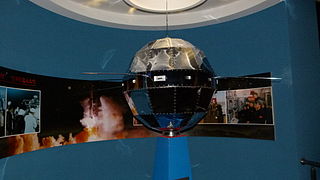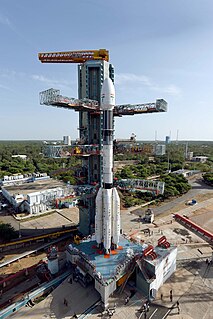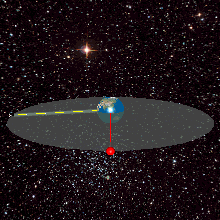
A geosynchronous orbit is an Earth-centered orbit with an orbital period that matches Earth's rotation on its axis, 23 hours, 56 minutes, and 4 seconds. The synchronization of rotation and orbital period means that, for an observer on Earth's surface, an object in geosynchronous orbit returns to exactly the same position in the sky after a period of one sidereal day. Over the course of a day, the object's position in the sky may remain still or trace out a path, typically in a figure-8 form, whose precise characteristics depend on the orbit's inclination and eccentricity. A circular geosynchronous orbit has a constant altitude of 35,786 km (22,236 mi).

A geostationary orbit, also referred to as a geosynchronous equatorial orbit (GEO), is a circular geosynchronous orbit 35,786 km (22,236 mi) in altitude above Earth's Equator and following the direction of Earth's rotation.
Syncom started as a 1961 NASA program for active geosynchronous communication satellites, all of which were developed and manufactured by the Space and Communications division of Hughes Aircraft Company. Syncom 2, launched in 1963, was the world's first geosynchronous communications satellite. Syncom 3, launched in 1964, was the world's first geostationary satellite.

A geosynchronous transfer orbit or geostationary transfer orbit (GTO) is a type of geocentric orbit. Satellites that are destined for geosynchronous (GSO) or geostationary orbit (GEO) are (almost) always put into a GTO as an intermediate step for reaching their final orbit.

A very-small-aperture terminal (VSAT) is a two-way satellite ground station with a dish antenna that is smaller than 3.8 meters. The majority of VSAT antennas range from 75 cm to 1.2 m. Bit rates, in most cases, range from 4 kbit/s up to 16 Mbit/s. VSATs access satellites in geosynchronous orbit or geostationary orbit to relay data from small remote Earth stations (terminals) to other terminals or master Earth station "hubs".

Dong Fang Hong 1, in the western world also known as China 1 or PRC 1, was the first space satellite of the People's Republic of China (PRC), launched successfully on 24 April 1970 as part of the PRC's Dongfanghong space satellite program. It was a part of the "Two Bombs, One Satellite" program. At 173 kg (381 lb), it was heavier than the first satellites of other countries. The satellite carried a radio transmitter which broadcast the de facto national anthem of the same name. The broadcast lasted for 20 days while in orbit.
Dongfanghong was a satellite program of the People's Republic of China. The program started in August 1965 as Project 651—a less ambitious successor to the earlier Project 581—with the goal of launching a satellite heavier than both Sputnik 1 and Explorer 1 into space, and developing all the necessary technologies to do so.

Geosynchronous Satellite Launch Vehicle (GSLV) is an expendable launch system operated by the Indian Space Research Organisation (ISRO). GSLV was used in fourteen launches from 2001 to 2021, with more launches planned. Even though GSLV Mark III shares the name, it is an entirely different launch vehicle.

ATS-6 was a NASA experimental satellite, built by Fairchild Space and Electronics Division It has been called the world's first educational satellite as well as world's first experimental Direct Broadcast Satellite as part of the Satellite Instructional Television Experiment between NASA and Indian Space Research Organisation (ISRO). It was launched May 30, 1974, and decommissioned July 1979. At the time of launch, it was the most powerful telecommunication satellite in orbit. ATS-6 carried no fewer than 23 different experiments, and introduced several breakthroughs. It was the first 3-axis stabilized spacecraft in geostationary orbit. It was also the first to use experimentally with some success electric propulsion in geostationary orbit. It also carried several particle physics experiments, including the first heavy ion detector in geostationary orbit.
AMOS-1, then INTELSAT 24, is a commercial communications satellite which was operated by Spacecom as AMOS-1, for Affordable Modular Optimized Satellite and formed part of the AMOS series of satellites. It was the first Israeli civilian communications satellite, and was initially positioned at 4° West longitude in geostationary orbit. Then in September 2011, it was moved to 31° East.
IndoStar-1, which also known as Cakrawarta-1, was a communication satellite that was launched the evening of November 12, 1997 at 21:48 GMT aboard an Ariane 44L-3 rocket from Kourou, French Guiana, as the first direct broadcasting satellite (DBS) in Asia, IndoStar-1 would initiate a new communication service for Indonesian society such as direct-to-home television.

The Symphonie satellites were the first communications satellites built by France and Germany to provide geostationary orbit injection and station-keeping during their operational lifetime. After the launch of the second flight model, they comprised the first complete telecommunications satellite system. They were the result of a program of formal cooperation between France and Germany.

A geosynchronous satellite is a satellite in geosynchronous orbit, with an orbital period the same as the Earth's rotation period. Such a satellite returns to the same position in the sky after each sidereal day, and over the course of a day traces out a path in the sky that is typically some form of analemma. A special case of geosynchronous satellite is the geostationary satellite, which has a geostationary orbit – a circular geosynchronous orbit directly above the Earth's equator. Another type of geosynchronous orbit used by satellites is the Tundra elliptical orbit.
The Long March 3B, also known as the CZ-3B and LM-3B, is a Chinese orbital launch vehicle. Introduced in 1996, it is launched from Launch Area 2 and 3 at the Xichang Satellite Launch Center in Sichuan. A three-stage rocket with four strap-on liquid rocket boosters, it is currently the second most powerful member of the Long March rocket family after the Long March 5 and the heaviest of the Long March 3 rocket family, and is mainly used to place communications satellites into geosynchronous orbits.
The initialism STTW may stand for:
Paksat-1R is a geosynchronous, communications satellite that was manufactured by China Great Wall Industry Corporation (CGWIC) and operated by the Space and Upper Atmosphere Research Commission (SUPARCO), an executive space authority of the Government of Pakistan.
Sino Satellite Communications Co., Ltd. known also as SinoSat is a Chinese company.
Dong Fang Hong was a space satellite program in the People's Republic of China.
Space Infrastructure Servicing (SIS) is a spacecraft concept being developed by Canadian aerospace firm MDA to operate as a small-scale in-space refueling depot for communication satellites in geosynchronous orbit.
Alcomsat-1 is the first Algerian communications satellite. It was carried by Chinese launcher Long March 3B from the Xichang Satellite Launch Center, located in Sichuan Province, 2,200 km southwest of Beijing.








